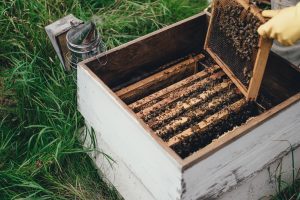
Climate Experience:
Beekeepers have noticed that hives are seeing an increased level of stress; some have even lost their queen.
Explanation:
- Climate change induced stress is endangering a species already under threat from pesticide usage.[1]
- Bees that live in hot climates have limited tolerance to additional heat stress.[2]
- Melbourne is getting hotter; the last 18 years have been above average temperatures.[3]
Ramifications:
- Continued warming risks phonological asynchrony, that is bees emerging at different times to its food source further endangering the species.[4]
- Bees may face extinction within the century.[5]
- Declines in bee population will have wide ranging impacts on agriculture, three out of four crops producing fruits or seeds for human use depend on bees for pollination.[6]
What can be done?
- Email your local MP and tell them that action on climate is important to you and explain the impacts being felt in your area. One email might not feel like much but most politicians consider it to be representative of 100 citizens.
- Help support the Act on Climate collective by donating; we are leading the charge for climate action. Your donation helps in advancing policies that prevent climate change from getting worse, we aim to empower communities and build a strong pro-climate-action constituency that governments can’t ignore, and as an added bonus it’s tax-deductable.
- Get involved with Act on Climate. We meet every Monday at 6pm (upstairs at 312 Smith St, Collingwood) and welcome all newcomers to join in the fight for climate justice. If you are unable to attend, follow us on Facebook, Twitter and Instagram to keep up with the latest campaign.
* We aim to keep our material as accurate and as relevant as possible. Working with climate science, a field that is being constantly updated, keeps us on our toes. Information on this site was gathered on June 1 2019; if you notice information that needs updating please let us know. For the full reference list please see the following.
_________________________________
[1]Yves Le Conte and Maria Navajas, “Climate Change: Impact on Honey Bee Populations and Diseases,” Revue Scientifique et Technique-Office International des Epizooties27, no. 2 (2008).507.
[2]Paul J CaraDonna, James L Cunningham, and Amy M Iler, “Experimental Warming in the Field Delays Phenology and Reduces Body Mass, Fat Content and Survival: Implications for the Persistence of a Pollinator under Climate Change,” Functional ecology32, no. 10 (2018).2345-6.
[3]“Australian Climate Change Site Data – Melbourne Regional Office”, Bureau of Meteorology, access April 23 2019, http://www.bom.gov.au/cgi-bin/climate/hqsites/site_data.cgi?variable=maxT&area=aus&station=086071&dtype=anom&period=annual&ave_yr=0
[4]CaraDonna, Cunningham, and Iler, “Experimental Warming in the Field Delays Phenology and Reduces Body Mass, Fat Content and Survival: Implications for the Persistence of a Pollinator under Climate Change.”2345.
[5]Ibid.https://besjournals.onlinelibrary.wiley.com/doi/abs/10.1111/1365-2435.13151
[6]Food and Agriculture Organization of the United Nations, “Why Bees Matter,” (Ljubljana2018).2.
